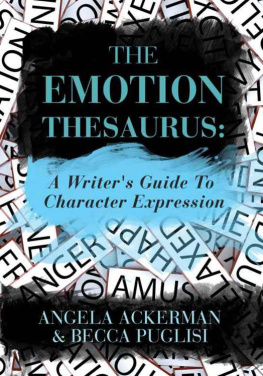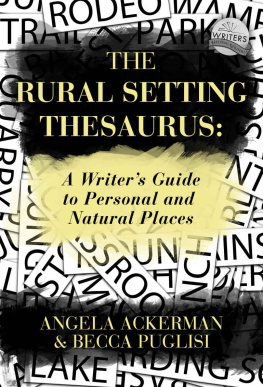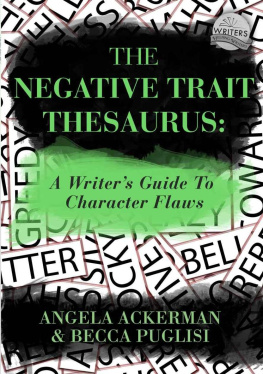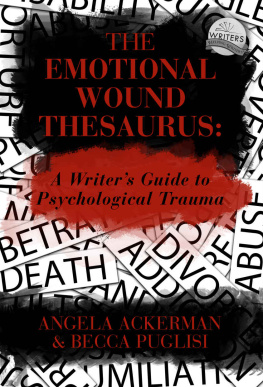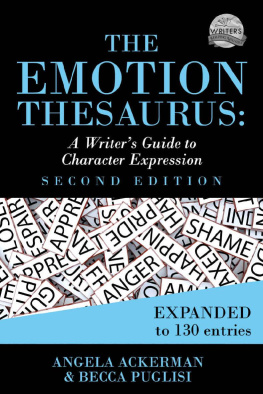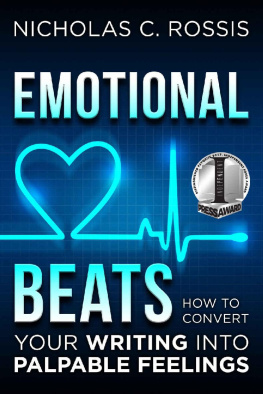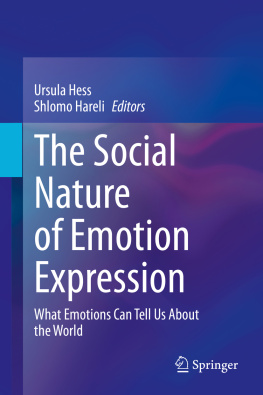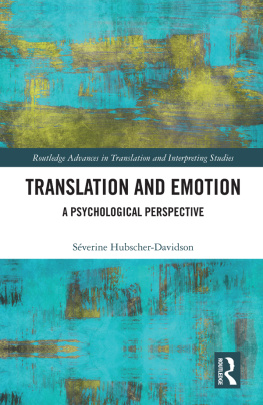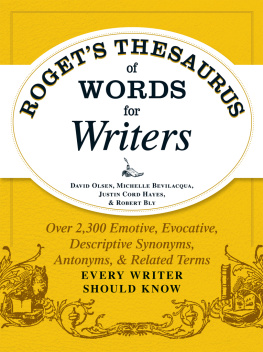The Emotion Thesaurus: A Writers Guide To Character Expression Angela Ackerman & Becca Puglisi Copyright 2012 by Angela Ackerman & Becca Puglisi Kindle Edition All rights reserved http://thebookshelfmuse.blogspot.com/ No part of this publication may be reproduced or distributed in print or electronic form without prior permission of the authors. Please respect the hard work of the authors and do not participate in or encourage the piracy of copyrighted materials. Edited in part by: Sharon Knauer Book cover design by: Scarlett Rugers Design 2012 http://www.scarlettrugers.com ebook formatting by: CyberWitch Press cyberwitchpress.com ABOUT THE AUTHORS Angela Ackerman is a member of the SCBWI and writes on the darker side of Middle Grade and Young Adult. She believes in the monster under the bed, eats French fries and ice cream together and is dedicated to paying it forward however she can. Angela lives in Calgary, Alberta in the shadow of the Canadian Rockies with her husband, two children, dog and zombie-like fish. Becca Puglisi is a YA fantasy and historical fiction writer, magazine author, and member of the SCBWI.
She resides in sunny south Florida, where she likes to watch movies, drink caffeinated beverages, and eat foods that arent good for her. She lives with her husband and two children. Together, Angela and Becca host The Bookshelf Muse , an award-winning online resource for writers that offers a number of different thesauri to aid authors in their descriptive writing efforts. ACKNOWLEDGEMENTS First and foremost, we want to thank the readers of The Bookshelf Musefor your support, encouragement, and kind words that made us see the need for a book version of The Emotion Thesaurus. Without all of you, this honestly never would have happened. We also want to acknowledge the very important members of our first critique group: Helen (Bookish), Roy (Grampy), Madeline (Maddog), Joan (Unohoo), and Laura (Goofus).
These Critique Circle writers helped us kick start this list and our respective writing careers. Our deepest appreciation also goes to our friend and editor Sharon, who encouraged us when we needed it most. We also owe a huge debt to the writing community at large. The writers we have met online, at conferences, at face-to-face groups, and in our own communities have been so generous with their knowledge and optimism, enabling us each to grow as writers. We love being part of this group. And finally, the biggest shout out goes to our families, who supported us though they couldnt see the vision, encouraged us when we struggled, and provided the business savvy we were lacking.
We owe it all to you. ~To AAD and SDJ, with all our love~ TABLE OF CONTENTS INTRODUCTION THE POWER OF EMOTION All successful novels, no matter what genre, have one thing in common: emotion. It lies at the core of every characters decision, action, and word, all of which drive the story. Without emotion, a characters personal journey is pointless. Stakes cease to exist. The plot line becomes a dry riverbed of meaningless events that no reader will take time to read.
Why? Because above all else, readers pick up a book to have an emotional experience. They read to connect with characters who provide entertainment and whose trials may add meaning to their own life journeys. As emotional beings, feelings propel us. They drive our choices, determine who we spend time with, and dictate our values. Emotion also fuels our communication, allowing us to share meaningful information and beliefs with others. And while it may seem that most exchanges happen through conversation, in truth up to 95% of all communication is nonverbal.
Even in instances where we try not to show our feelings, we are still sending messages through body language. Because of this, each of us becomes adept at reading others without a word being said. As writers, we must take our innate skills of observation and transfer them to the page. Readers have high expectations. They dont want to be told how a character feels; they want to experience the emotion for themselves. To make this happen, we must ensure that our characters express their emotions in ways that are both recognizable and compelling to read.
VERBAL AND NONVERBAL COMMUNICATION Dialogue is a proven vehicle for expressing a characters thoughts, beliefs, and opinions, but it cannot deliver a full emotional experience by itself. To convey feelings well, a writer must also utilize nonverbal communication, which can be broken down into three elements: physical signals (body language and actions), internal sensations (visceral reactions) and mental responses (thoughts). PHYSICAL SIGNALS are how our bodies outwardly respond when we experience emotion. The stronger the feeling, the more the body reacts and the less conscious control we have over movement. Because characters are unique, they will express themselves in a specific way. Combine the vast number of physical signals with the individuality of each character, and a writers options for showing emotion through body language and action are virtually limitless.
MENTAL RESPONSES act as a window into the thought process that corresponds with an emotional experience. Thoughts are not always rational and can skip from topic to topic with incredible speed. Utilizing thought as a way to express emotion is an excellent way to convey to the reader how a character sees their world. Thoughts add a layer of meaning by illustrating how people, places, and events affect the POV (point of view) character and can also be an excellent way to demonstrate voice. INTERNAL SENSATIONS are the most powerful form of nonverbal communication and should be used with the most caution. These visceral reactions (breathing, heart rate, light-headedness, adrenaline spikes, etc.) are raw and uncontrolled, triggering the fight-or-flight response.
Because these are instinctive body responses, all people experience them. As such, readers will recognize and connect with them on a primal level. The very nature of these heightened visceral reactions requires writers to take special care when using them. Relying too much on internal sensations can create melodrama. Also, because visceral responses are limited, a writer can inadvertently use clichd phrasings when describing them. A light touch is needed with this type of nonverbal communication, as a little goes a long way.
THE BALANCING ACT It is easy to see the power of emotion and how it connects a reader to the story and characters. The difficulty comes in writing it well. Each scene must achieve a balance between showing too little feeling and showing too much. Above all, the emotional description needs to be fresh and engaging. This is a tall order for writers who tend to reuse the same emotional indicators over and over. The Emotion Thesaurus addresses this difficulty by helping writers brainstorm new ideas for expressing a characters emotional state.
But what about other pitfalls associated with portraying emotion? The following section explores a few of these common trouble spots and suggests techniques for overcoming them. WRITING NONVERBAL EMOTION: AVOIDING COMMON PROBLEMS TELLING By definition, nonverbal emotion cant be told. It has to be shown. This makes it difficult to write because telling is easier than showing. Heres an example: Mr. Paxtons eyes were sad as he gave her the news.
Im sorry, JoAnne, but your position with the company is no longer necessary.Instantly, JoAnne was angrier than shed ever been in her life. This exchange is fairly easy to writebut not so easy to read. Readers are smart and can figure things out for themselves. They dont want to have the scene explained to them, which is what happens when a writer tells how a character feels. Another problem with telling is that it creates distance between the reader and your characters, which is rarely a good idea. In the preceding example, the reader sees that Mr.
Next page
